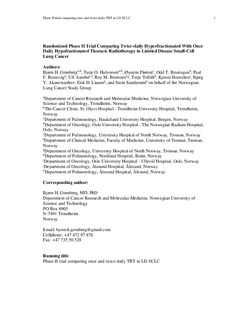| dc.description.abstract | Background: Concurrent chemotherapy and thoracic radiotherapy (TRT) is recommended for limited disease small cell lung cancer (LD SCLC). Twice daily TRT is well documented, but not universally implemented – probably mainly due to inconvenience and concerns about toxicity. A schedule of three-week hypofractionated TRT is a commonly used alternative. This is the first randomized trial comparing twice daily and hypofractionated TRT in LD SCLC.
Material and methods: Patients received four courses of cisplatin/etoposide (PE) and were randomized to TRT of 42 Gy in 15 fractions (once daily, OD) or 45 Gy in 30 fractions (twice daily, BID) between the second and third PE course. Good responders received prophylactic cranial irradiation of 30 Gy in 15 fractions.
Results: 157 patients were enrolled between May 2005 and January 2011 (OD: n = 84, BID: n = 73). Median age was 63 years, 52% were men, 84% had performance status 0–1, 72% had stage III disease and 11% non-malignant pleural effusion. The treatment arms were well balanced. The response rates were similar (OD: 92%, BID: 88%; p = 0.41), but more BID patients achieved a complete response (OD: 13%, BID: 33%; p = 0.003). There was no difference in one-year progression-free survival (PFS) (OD: 45%, BID: 49%; p = 0.61) or median PFS (OD: 10.2 months, BID: 11.4 months; p = 0.93). The median overall survival in the BID arm was 6.3 months longer (OD: 18.8 months, BID: 25.1 months; p = 0.61). There were no differences in grade 3–4 esophagitis (OD: 31%, BID: 33%, p = 0.80) or pneumonitis (OD: 2%, BID: 3%, p = 1.0). Patients on the BID arm reported slightly more dysphagia at the end of the TRT.
Conclusion: There was no difference in severe toxicity between the two TRT schedules. The twice daily schedule resulted in significantly more complete responses and a numerically longer median overall survival, but no firm conclusions about efficacy could be drawn from this phase II trial. | nb_NO |
